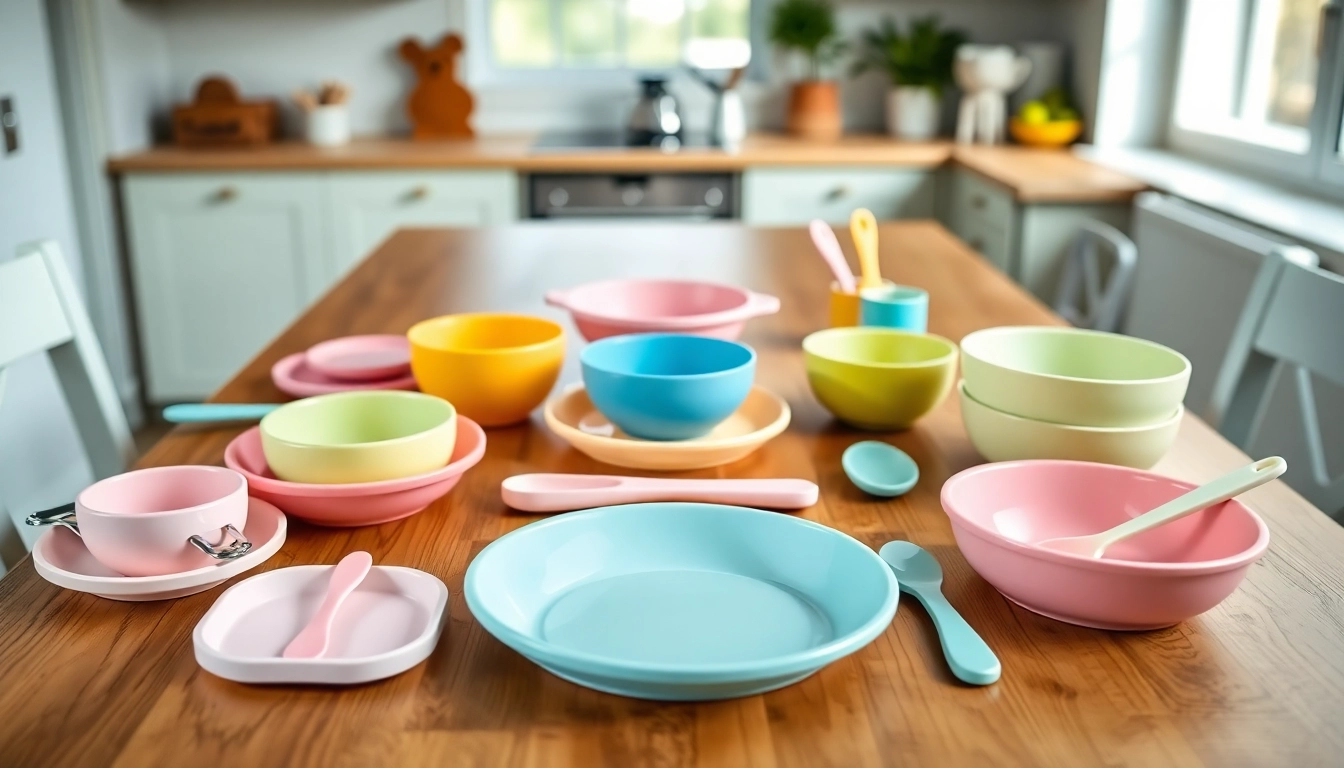Understanding the Importance of Baby Feeding Sets for Weaning
Weaning marks a crucial milestone in a baby’s development, symbolizing a transition from exclusive milk feeding to exploring a broader range of solid foods. During this phase, the choice of appropriate feeding tools becomes essential to promote independence, ensure safety, and foster positive mealtime habits. A well-designed Baby feeding set for weaning can significantly influence a child’s eating experience, support motor development, and build confidence in self-feeding. The right set not only simplifies parents’ routines but also aligns with the baby’s growing needs, making the journey of weaning both effective and enjoyable.
Benefits of Using Specialized Feeding Sets in Early Development
Using specialized feeding sets designed for weaning offers numerous benefits that extend beyond mere practicality. These sets are typically crafted from non-toxic, durable materials like certified silicone, emphasizing safety and longevity. They help establish structured mealtime routines, encouraging babies to learn self-feeding skills that are vital for independence. Additionally, the use of divided plates, bowls, and ergonomic utensils introduces babies to different textures and consistencies, stimulating sensory development and motor skills.
Research indicates that babies who are introduced to appropriate feeding tools tend to develop better hand-eye coordination, improved chewing ability, and a more positive attitude towards diverse foods. Moreover, these tools can reduce mess and frustration, making mealtimes calmer and more engaging for both child and parent. For example, silicone accessories with anti-slip features provide stability, preventing accidental spills and fostering confidence during self-feeding practice.
Key Features to Look for in a Baby Feeding Set for Weaning
Choosing an ideal feeding set involves understanding key features that ensure safety, functionality, and developmental support. These include:
- Material Safety: Opt for sets made from certified silicone or BPA-free plastics. Silicone in particular is resistant to staining and odors, flexible, and safe for chewing.
- Design and Ergonomics: Look for utensils with ergonomic handles that fit comfortably in tiny hands, facilitating a natural grip and developing fine motor skills.
- Divided Plates and Bowls: Compartments separate different foods, preventing cross-contamination and encouraging variety in meals.
- Anti-slip Features: Non-slip bases or ventosas (suction cups) that secure the set to the table help minimize mess and frustration.
- Ease of Cleaning: Dishwasher-safe and easy to sterilize. Smooth surfaces without intricate crevices prevent bacteria buildup.
Incorporating these features ensures that both functionality and safety are prioritized, creating an optimal environment for introducing new foods and fostering independence.
Common Challenges When Choosing the Right Feeding Set
Parents often face challenges selecting the best baby feeding set, primarily due to market saturation and confusing product options. Common issues include:
- Material Concerns: Uncertified plastics that may contain harmful chemicals like BPA or phthalates.
- Durability: Fragile utensils that break easily or wear out quickly, leading to frequent replacements.
- Design Limitations: Non-ergonomic shapes that are difficult for small hands to grip or that do not promote self-feeding.
- Size and Capacity: Sets that are too small or too large, causing inconvenience during meals.
- Cost and Value: High prices without corresponding quality or educational benefits.
Addressing these challenges involves thorough research and prioritizing safety certifications, user reviews, and product features that align with the baby’s developmental stage. For example, opting for certified silicone sets like those from Bèbeboom, which are free from BPA and ftalates, can mitigate health risks and ensure longevity.
Types of Baby Feeding Sets for Weaning and Their Unique Features
Silicone vs. Plastic Feeding Sets: Which Is Better?
When selecting a feeding set, the primary material considerations are silicone and plastic. Silicone, especially food-grade certified silicone, is preferred for its flexibility, safety, and durability. It is resistant to stains, odours, and can withstand high temperatures for sterilization. Silicone feeding sets often feature built-in suction cups, providing anti-slip stability—perfect for active little eaters.
Plastic sets, on the other hand, are typically lightweight and inexpensive, but may contain harmful chemicals if not properly certified. They are also prone to cracking over time. Therefore, high-quality BPA-free, food-grade plastics are recommended if choosing plastic options. Overall, silicone is generally regarded as the superior choice for safety and longevity, particularly in the context of modern, certified baby accessories.
Design Variations: Divided Plates, Bowls, and Utensils
Designs vary widely to cater to different developmental needs and preferences. Divided plates, such as those shaped like rainbows or with three compartments, help organize meal portions and make food presentation appealing. Bowls with suction bases prevent accidental tipping, promoting independence in self-feeding.
Utensils include ergonomically designed spoons and forks, with small, soft handles suitable for tiny hands. Some sets incorporate innovative features such as flexible silicone tips to improve gag reflex tolerance and ease of use. These variations support the baby’s evolving motor skills and acceptance of diverse textures.
Leek-proof and Non-slip Features Explained
Leak-proof and non-slip features are critical to creating a stress-free mealtime environment. Suction cups or ventosas in silicone plates and bowls adhere securely to surfaces, reducing messes caused by accidental slips or curiosity-driven movements. Additionally, leak-proof lids for storage containers facilitate easy transport of baby meals, preventing spills in bags or strollers.
Choosing sets with high-quality suction mechanisms ensures safety and minimizes clean-up time, benefiting both parents and children. For instance, Bèbeboom’s silicone accessories incorporate these features seamlessly, making them practical for use at home and on the go.
Step-by-Step Guide to Introducing a Baby Feeding Set for Weaning
Timing and Readiness Signs for Weaning
Parents should look for signs of readiness before introducing a baby feeding set. These include good head control, ability to sit unassisted, interest in food, and showing curiosity towards family mealtimes. Typically, this occurs between 4 to 6 months of age, but individual development varies. Ensuring that the baby is physically and cognitively prepared lays the foundation for successful self-feeding.
Tips for Making Mealtime Enjoyable and Stress-Free
To foster a positive mealtime experience, establish a routine and create a calm environment. Use bright, engaging plates and utensils to attract attention and encourage participation. Allow the baby to explore the food and utensils without pressure, celebrating successes to build confidence. Additionally, involving the child in simple tasks like holding a spoon or helping to set the table promotes independence and joy.
Involving Your Baby in Self-feeding Using the Right Set
Choosing appropriately sized and ergonomic utensils enhances a baby’s ability to grasp and manipulate food. Silicone spoon sets with small handles and soft tips are ideal for beginners. Demonstrating and modeling self-feeding behaviors, alongside providing encouraging feedback, solidifies learning. Always supervise and be patient, recognizing that messy outcomes are part of the developmental process.
Maintaining Safety, Hygiene, and Durability of Baby Feeding Sets
Cleaning and Sterilizing Best Practices
Robust cleaning routines are essential to prevent bacterial growth and ensure safety. Most silicone sets are dishwasher safe, but careful hand washing with mild soap is recommended for delicate components. Regular sterilization—boiling or using sterilizing solutions—further enhances hygiene, especially during the initial phases of self-feeding when babies put utensils in their mouths frequently.
Materials Safety Certifications to Consider
Always verify that the feeding set complies with certifications such as FDA, LFGB, or European EN standards. Certifications confirm that the materials are free from harmful substances like BPA, lead, and phthalates. Reputable brands like Bèbeboom prioritize these standards, giving parents peace of mind regarding safety and health.
Longevity Tips for Active Little Eaters
Choosing durable, high-quality materials, avoiding harsh chemicals, and inspecting for wear regularly prolong the lifespan of feeding accessories. Proper storage and avoiding exposure to extreme temperatures or direct sunlight further preserve their integrity. Investing in high-grade silicone sets can withstand years of active use, supporting multiple children or the entire weaning process.
Real-Life Success Stories and Expert Recommendations
Parent Testimonials on Using Baby Feeding Sets for Weaning
Many parents report that silicone feeding sets transformed their child’s mealtimes by making them more engaging and less stressful. For example, Maria, a first-time mother, shares how using a suction-based bowl made her toddler more confident in self-feeding, reducing frustration and mess.
Expert Advice on Transitioning to Self-feeding
Pediatric nutritionists recommend introducing utensils early, encouraging exploration without pressure. An expert suggests choosing sets that promote tactile learning, such as soft, flexible silicone, and emphasizing patience and positive reinforcement as children learn new skills.
Innovative Features That Make Mealtime Easier for Parents
Designed with modern parenting in mind, features such as stackable sets, adjustable utensil lengths, and integrated splash guards help streamline mealtime routines. Brands emphasizing safety, like Bèbeboom, often incorporate these features, ensuring functionality complements child development needs.





